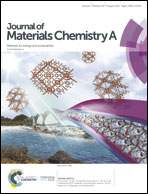Rational construction of macroporous CoFeP triangular plate arrays from bimetal–organic frameworks as high-performance overall water-splitting catalysts†
Abstract
Metal–organic frameworks (MOFs) are widely considered as electrochemically active materials. However, direct application of MOFs is hindered by their poor conductivity and stability. MOF-derived materials, generally obtained by carbonization or phosphidation of MOF crystals at high temperature, suffer inevitably from insufficient exposure of active sites because of the micropore regime of most MOF precursors (≤3 nm). Here, using CoFe bimetal–organic framework triangular plate arrays (CoFe-MOF TPAs/Ni) as a precursor, we developed a facile strategy to prepare Fe-rich Macroporous CoFeP Triangular Plate Arrays (Macroporous CoFeP TPAs/Ni) as an overall water splitting catalyst. We found that selectively etching organic ligands from CoFe-MOF TPAs/Ni can result in the formation of large interconnected pores in the planes and the follow-up phosphorization can further yield Macroporous CoFeP TPAs/Ni. The obtained Macroporous CoFeP TPAs/Ni exhibit excellent activity towards both the HER and OER in 1 M KOH. Driving HER current densities of 10, 100 and 900 mA cm−2 requires overpotentials of only 43, 113 and 263 mV, respectively, while delivering OER current densities of 10, 100 and 700 mA cm−2 needs only 198, 250 and 335 mV, respectively. At a current density of 10 mA cm−2, the Macroporous CoFeP TPAs/Ni‖Macroporous CoFeP TPAs/Ni requires a cell voltage as low as 1.47 V for overall water splitting. The activity and stability of Macroporous CoFeP TPAs/Ni in 1 M KOH are comparable to those of state-of-the-art bifunctional electrocatalysts and even superior to those of noble-metal based ones at large current densities. Furthermore, this strategy can be extended to the synthesis of CoFe-based nitrides, sulfides and selenides. The study provides a promising approach for the development of viable alternatives to noble-metal based materials for industrial water splitting.



 Please wait while we load your content...
Please wait while we load your content...